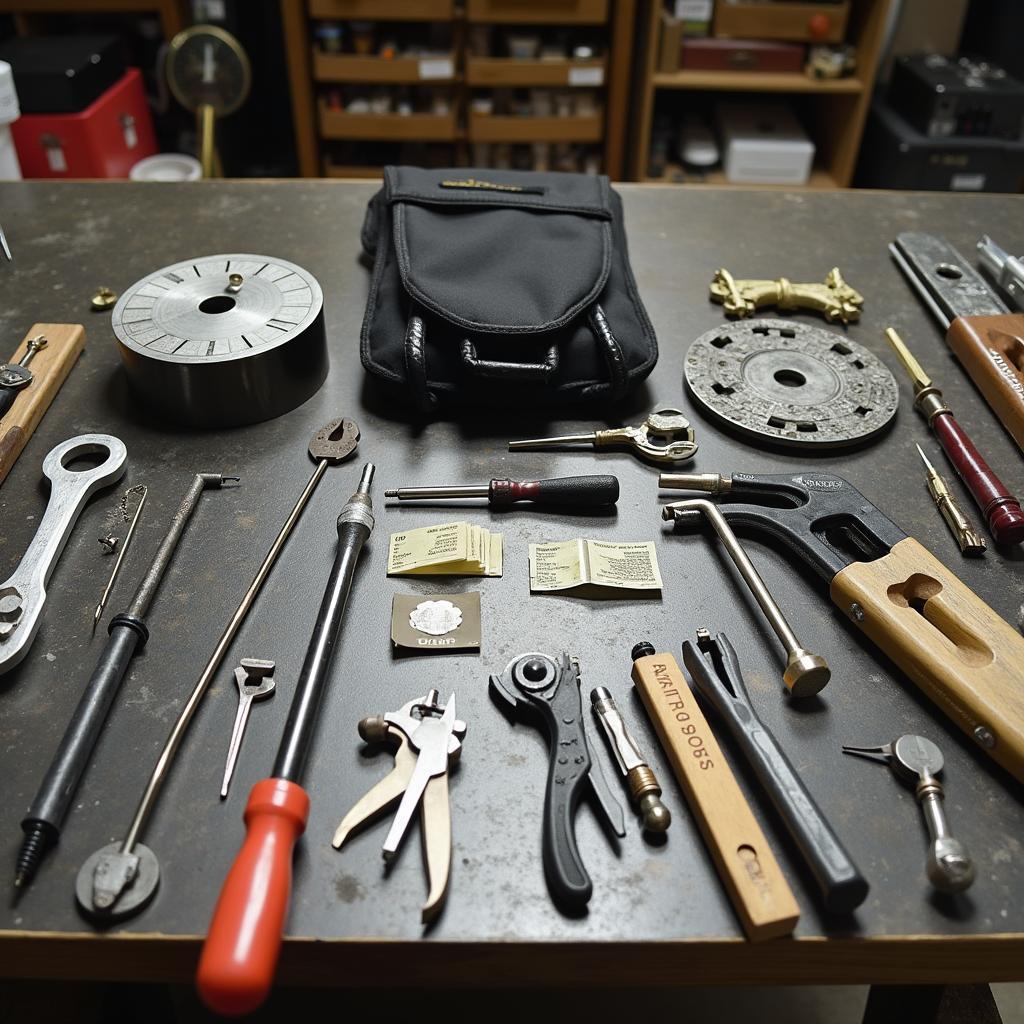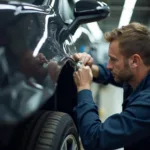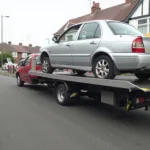Paintless dent repair (PDR) has revolutionized the way minor dents and dings are fixed. This method allows technicians to remove dents without affecting the vehicle’s original paint job, preserving its value and saving time. Central to this process are specialized car body paintless dent repair tools, with PDR pullers being a cornerstone. This guide delves into the world of PDR tools, focusing on the indispensable PDR puller and its role in achieving flawless dent removal.
Understanding PDR and its Advantages
PDR is a technique that uses specialized tools to massage dents out from the backside of a panel. It’s a meticulous process that requires skill and the right set of tools to restore a vehicle’s body to its pristine condition.
Benefits of PDR:
- Preserves Original Paint: Since PDR doesn’t require repainting, the original factory finish remains intact, preventing issues like color mismatch and overspray.
- Cost-Effective: Compared to traditional bodywork, PDR is often significantly more affordable, especially for smaller dents and dings.
- Time-Saving: PDR repairs are generally quicker than traditional methods, minimizing the time your vehicle spends in the shop.
- Environmentally Friendly: PDR eliminates the need for harsh chemicals and paints, making it an environmentally sound choice.
 PDR Tools Kit
PDR Tools Kit
The PDR Puller: A Closer Look
The PDR puller, also known as a dent puller, is a key tool in any PDR technician’s arsenal. It’s designed to pull out dents from the outside of the panel, working in conjunction with other PDR tools to achieve a seamless repair.
Types of PDR Pullers
PDR pullers come in various shapes and sizes to cater to different dent sizes and locations:
- Screw-Type Pullers: These are the most basic type, using a threaded screw to exert pulling force on a glue tab attached to the dent.
- Slide Hammer Pullers: These offer more pulling power than screw-type pullers and are suitable for larger or more stubborn dents.
- Lever-Type Pullers: These provide controlled leverage for precise dent removal, ideal for delicate areas or smaller dents.
- Glue Pullers: Utilizing specialized glue tabs and a pulling mechanism, these are excellent for accessing hard-to-reach dents.
How to Use a PDR Puller
Using a PDR puller effectively requires practice and precision:
- Clean the Dent: Thoroughly clean the dented area to ensure proper adhesion of the glue tab.
- Apply Glue Tab: Choose an appropriate size glue tab and attach it to the center of the dent using a hot glue gun.
- Attach the Puller: Secure the PDR puller to the glue tab, ensuring a firm grip.
- Apply Pulling Force: Gradually apply pulling force on the puller, either by turning a screw, pulling a lever, or using a slide hammer mechanism.
- Check Progress: Regularly check the progress of the dent removal, stopping once the dent is flush with the surrounding panel.
- Remove Glue Tab: Carefully remove the glue tab and any residual glue using a plastic razor blade and adhesive remover.
Choosing the Right PDR Tools for the Job
Selecting the right PDR tools is crucial for achieving optimal results. Factors to consider include:
- Dent Size and Location: Different tools are suited for different dent sizes and locations. For example, smaller dents in easily accessible areas might only require a simple tap down tool and a knock-down tool, while larger dents or those in difficult-to-reach areas might necessitate a slide hammer puller or a glue pulling system.
- Skill Level: Beginner technicians might benefit from starting with basic tools and gradually expanding their kit as their skills develop. More experienced technicians often have a wider range of specialized tools to tackle complex repairs.
- Budget: PDR tools come in a range of prices. It’s essential to choose tools that fit your budget while still meeting your specific needs.
Beyond the Puller: Essential PDR Tools
While the PDR puller plays a vital role, a comprehensive set of PDR tools is essential for professional results:
- Dent Lifters: These tools are used to gently push out dents from the inside of the panel.
- Tap Down Tools: These tools are used in conjunction with a knock-down tool to tap down high spots created during the dent removal process.
- Glue Tabs: Available in various shapes and sizes, these tabs are used with glue pullers to grip and pull dents.
- Reflective Boards: These boards help technicians see the contours of the dent more clearly by reflecting light onto the panel.
- Heat Gun: A heat gun can be used to soften the glue for easier removal of glue tabs.
Mastering the Art of PDR
Becoming proficient in PDR requires both theoretical knowledge and hands-on experience. Consider enrolling in PDR training courses or workshops to learn from experienced technicians. Practice is key to mastering the techniques and developing the necessary feel for the tools.
Expert Insight:
“The key to successful PDR lies in understanding the metal’s memory and using the right tools with the right amount of pressure. It’s about finesse and precision rather than brute force.” – John Miller, Master PDR Technician with 20+ years of experience.
Conclusion
Car body paintless dent repair tools, with the PDR puller at the forefront, have transformed the way minor dents are repaired. This cost-effective, time-saving, and environmentally friendly approach preserves a vehicle’s original finish while delivering exceptional results. Whether you’re a car enthusiast looking to learn more about PDR or a professional technician seeking to expand your toolkit, understanding the capabilities of PDR tools is crucial. Remember, investing in quality tools and continuous learning are key to achieving mastery in the art of PDR.
FAQs about Car Body Paintless Dent Repair Tools
1. Can all dents be repaired with PDR?
While PDR is highly effective for many dents, not all dents are good candidates. Dents that are too large, have sharp creases, or are located in areas with restricted access might not be suitable for PDR.
2. Is PDR safe for my car’s paint?
Yes, when performed correctly by a skilled technician, PDR is completely safe for your car’s paint. The process doesn’t require sanding, filling, or repainting, preserving the original factory finish.
3. How much does PDR cost?
The cost of PDR can vary depending on factors like the size and location of the dent, the type of vehicle, and the technician’s experience. However, it’s generally more affordable than traditional bodywork.
4. How long does a PDR repair take?
PDR repairs are typically quick, with many smaller dents being repairable within an hour or two. Larger or more complex dents might require additional time.
5. Can I learn PDR myself?
While it’s possible to learn the basics of PDR, it’s a skilled trade that requires practice and patience. Consider enrolling in a reputable PDR training program to gain the necessary skills.
Looking for Car Body Repair Experts?
If you’re in need of professional car body repairs, check out our services:
- Car body repairs North Down
- Montgomery car body repairs Belfast
- Car body repairs Blackburn Aberdeenshire
For other locations and services, browse our website for more information. We’re here to help you restore your vehicle to its former glory!
Need immediate assistance? Contact us via WhatsApp: +1(641)206-8880, Email: [email protected]. Our dedicated customer support team is available 24/7 to answer your queries and schedule appointments.


